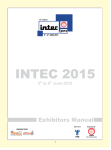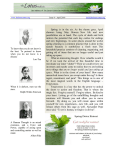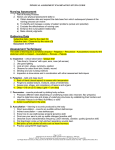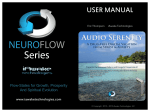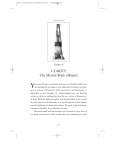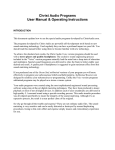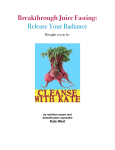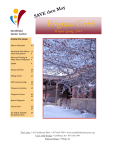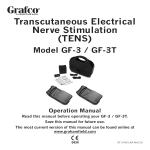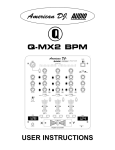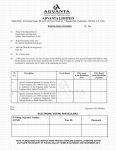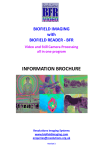Download THE ACCIDENTAL YOGI`S MANUAL
Transcript
THE ACCIDENTAL YOGI’S MANUAL By Kevin Curtis © Kevin Curtis 2013 A Note on copyright: I, the author, give permission for this manual to be reproduced and shared as long as the following three conditions are met: 1. The manual must not be altered in any way. 2. The author must be given full credit. 3. When sharing, the manual must be shared for free. A word of caution: The material contained in this manual is informational only. It is not intended to diagnose, treat, cure, or be substituted for medical supervision. Please consult your physician for treatment of all medical conditions. How to use this manual I've designed this manual to be used in a step by step, progressive manner. This means, as you work through the exercises, each new practice you learn will build on and enhance what you've already done. I suggest you work through the manual from start to finish. Spend time with each practice before moving onto the next. For example, you may want to spend your first week getting used to the sitting position (siddhasana). Once you're used to Siddhasana you can incorporate the next practice (moola bandha) into your routine. After a week of practicing moola bandha, while sitting in siddhasana, you can add the next practice and so on until you've worked your way through the entire manual. And of course you don't have to spend just one week on each new practice, you can extend that time to two weeks, a month, a year, or whatever's most comfortable for you. We're not in a hurry, it's not a race we're in. We're all different, so adjust the times spent on each new practice to suit your self. An important point to mention is that all of the practices in this manual are synergistic, they all work together, with each new practice supporting and enhancing what you've already learned. So don't lose heart if you're physically unable to do everything. Just doing one or two of the practices is enough to achieve the same goals that a full set of practices will achieve (the only difference is that it may take you a little longer to see the results but you'll still get there in the end). CONTENTS INTRODUCTION • Effects of practice – Vagus nerve, waking up the heart and brain PRELIMINARIES • Attitude – regularity, enthusiasm, setting goals • Diet • Exercise • Breathing SADHANA – PRACTICES BANDHAS • Root lock -‐ Moola • Abdominal lock -‐ Uddiyana • Neck lock -‐ Jalandhara • Khechari • Shambhavi • Agni sara • Nauli • Maha mudra • Maha bandha • Maha veda PRANAYAMA – BREATH CONTROL • Ujaji • Bhastrika • Anuloma viloma MANTRA • Bija mantra BHAKTI INTRODUCTION My yoga journey has never been one that I’d class as being normal or usual. In fact, I’ve never even been to a yoga class nor had a Guru, in the traditional sense. When I think about it, I don’t think I ever really practiced yoga. My journey has been more of a case of yoga happening to me. Yoga, for me, has always been a spontaneous process. As far back as I can remember, even as a young child, I spent hours by myself thinking thoughts on life and how everything around me seemed to be connected and alive-‐ pulsating with an unseen energy of some sort. From an early age my mind had a tendency to turn inward and become naturally meditative. I remember “playing” with my stomach muscles when I was around nine years old. I say playing because that’s what it was for me at that age. It was only later, when I read a book on yoga, that I found out that the muscle contractions and manoeuvres I was doing back then had specific names in the various yoga traditions. It turns out that I was practicing Uddiyana Bandha, Nauli Kriya, and Agni Sara -‐ all practices that have powerful physical effects on the nervous system, brain, and endocrine system, conducive to meditation and what I’ve come to call the awakening process. Other things that seemed completely natural began to happen to me as I matured through my teenage years. My breathing rhythm slowed from an average 16 breaths per minute to about 6 breaths per minute by the time I reached my late teens, and dropped further to 4 breaths per minute as I progressed through my twenties, where it has levelled off. My diet also gradually changed to ovo-‐vegetarian. All of these things, as well as the spontaneous muscle movements that were going on, I found out, were part of my awakening. It’s only over the past 10 years have I begun to realise that yoga is a process that had been happening to me all of my life. The muscle contractions, the strange breathing patterns, the rushes of electrical energy through my body, the patterns of coloured light I see when I close my eyes, all of these things have been known to Yogis for centuries as kriyas, or spontaneous manifestations of an energy they call kundalini. It’s said that when this energy awakens, she (kundalini is seen as a feminine energy) causes both physical and mental (neurological) changes in the yogi. These changes, as I’ve come to experience, result in ever deepening states of awareness and an unshakable inner peace and bliss that are so intense no words seem adequate enough to describe them. REVERSE ENGINEERING As I realised what was happening to me was a natural awakening process, it dawned on me that this same thing had happened many times throughout history to hundreds of other people, and was still happening to people all around the world. That was when I realised that the many different systems of Yoga were, in fact, the result of some of those people delineating their own awakening process and reversing the order of that process so that others could follow the path they had laid. Those Yogis of the past had reverse engineered their awakening. By applying this same understanding of reverse engineering, I have put together this manual based on the process that has been unfolding in my body and mind for the past 32 years. It’s my hope that in doing this I can offer some direction and much needed understanding to other people travelling their own path of awakening. Biology of Awakening The idea of awakening, in a nutshell, is to manipulate the inner workings of the body in a way that causes specific changes to take place within the brain, which in turn trigger the experience of higher states of consciousness and a feeling of deep love and connectedness to all beings. For this reason every practice contained in this manual is designed to have a very specific influence on your body (in particular the nervous and endocrine systems). One particular hormone/neurotransmitter that these practices stimulate into production is oxytocin, or as I've come to call it "the hormone of awakening." Why is oxytocin so important and central to the awakening process? It turns out that oxytocin is released from the brain at every major point in your life. Oxytocin flooded your parent's body's at the time of your conception, it was released in copious amounts when your mother gave birth to you; it was released into you and your parent's bodies every time they lovingly gazed into your eyes, as you were feeding and every time they hugged and kissed you. As you began to grow and form your own romantic relationships oxytocin was released every time you gazed into your lover's eyes, when you both embraced, and when you made love. And if you've had children or plan to have children that same cycle will continue. So what does oxytocin do? It helps us bond, it promotes feelings of belonging, it generates feelings of love and affection, and even altruism and a sense of connectedness or oneness. On a more physical level oxytocin triggers a relaxation response in the body, which promotes healthy organ function and a peaceful state of mind conducive to meditation. How do the practices of yoga influence the production of oxytocin? From a physiological perspective, we can cause a release of oxytocin and a bunch of other neurochemicals that sharpen the mind and lift the mood by waking up some of the deep brain structures. We can do this by stimulating various nerves in the body, namely the vagus and trigeminal nerves. All of the techniques in this manual have a stimulating effect on either one of these nerves. When stimulated, the vagus and trigeminal nerves-‐ • Positively alter your emotional state (enhancing positive moods to promote happiness, compassion, love, and altruism) • Alter the activity of the nervous system, inducing relaxation and a slowing down of the body's biological processes (reducing blood pressure, heart rate, respiration, etc), which makes the mind calm and meditative. • Reduce pain in the body. • Switch on the frontal lobes (to make you more intelligent, while enhancing mental focus and critical thinking). • Enhance memory function. There's also a third bunch of nerves called the pelvic splanchnic nerves that can also be stimulated to cause a release of oxytocin into the body. Stimulating these nerves has an indirect effect on the brain that works by generating a type of pre-‐orgasmic state in the yogi. Oxytocin is released just prior to orgasm in both men and women. The yogi, by maintaining a pre-‐orgasmic state through the stimulation of the pelvic splanchnic nerves, is able to maintain a constant supply of oxytocin in his/her body. By regularly stimulating the vagus, trigeminal, and pelvic splanchnic nerves you're training your brain and nervous system to act and behave in a way that's conducive to deep states of meditation, inner peace and bliss. However, it should be pointed out that training the brain and nervous system is just like any other type of training, to get good you must practice regularly. By doing these practices, you're making physical changes to your nervous system and brain. You're literally re-‐engineering your body in a way that causes your mind to experience expanded states of awareness and spontaneous realisations of your unity and connectedness with all things. A second hormone that plays an important role in expanding our state of consciousness is dopamine, which is also released when the vagus and trigeminal nerves are stimulated. Dopamine, released during orgasm, is what makes you feel high and completely elated, it's also the same hormone released when heroin addicts shoot up, giving them their high and ultimately leading to their addiction. Dopamine also works as an aid to help focus the attention, the very basis of meditation. The key to using dopamine is not to have too much or too little present in the body as either excessive or depleted levels can have an ill effect on the body and mind. When we stimulate specific nerves through our yoga practices we are essentially drip-‐feeding the body dopamine which causes a general sense of wellbeing and excitement felt for the majority of our waking lives. These feelings add to the sense of love and compassion a yogi feels towards others while enhancing that sense of blissful unity experienced in the depths of meditation. (Interestingly dopamine plays a key role in time perception, something that is often reported distorted during meditation) Your Ever Changing Brain An important element of the awakening process we need to be aware of is how our brains change as we progress through our practices. Neuroscience says that your brain is in a constant state of change. Every thing you do and experience you have causes your brain to rewire itself. For example, when you ride a bike for the first time neurons from all around your brain start firing at the same time. As those neurons fire together they form connects with each other. Every time you ride a bike from then on, those same neurons will fire together again and again, forming stronger connections each time you ride. This is why the more you practice the better you get. Applying this understanding of neurological rewiring to yoga, each time you do a specific practice it becomes easier because your brain and nervous system are being conditioned every time you repeat the same exercise. This is why regular and consistent practice is better than sporadic inconsistent practice. This rewiring applies to both physical techniques and meditative practices. What's really interesting about this is that when we start combining both physical and mental practices together we create a type of neurological switch. So for example, if I join my hands in a specific way (in yoga this is called a hand mudra) each time I meditate, a neurological connection is formed between my meditative state of mind and that specific hand position. This means after repeating my meditation, while using this hand position, a number of times it will become possible for me to trigger a spontaneous meditative state simply by forming that hand mudra. In this instance I'll have used a physical technique to trigger a mental state of mind. It should be noted that this also works in the opposite direction, whereby you can focus your mind to trigger a specific physical response, as in the advanced practice of mula bandha discussed later. Progress I should point out that while you may often feel as if the practices aren't having any affect on you, know that many changes are taking place deep below the surface. And while some of these changes are obvious, such as the slowing of your breathing and heart rate, and the deep sense of relaxation and pleasure you may feel, other changes aren't so quick to take effect. For instance, the changes and physical restructuring triggered in the frontal lobes and emotional centres of your brain by the stimulation of the vagus nerve take place weeks and months before their benefits are realised. This is interesting because it can just hit you one day. You simply wake up one morning and realise you're happy, really happy, much happier than you ever remember being. Effects of the practices Once you begin doing the practices explored in this manual you'll begin to notice a few changes taking place in your body and mind. Some of those changes will be subtle and barely noticeable while others will be blatant and unmissable. The following is a list of things that may or may not happen to you, based on my personal experience and the experience of other people I've spoken with who have gone through a similar process: The aim of this yoga isn't to attain some mystical state of consciousness that's beyond the grasp of "normal" people, nor is it to gain the super human powers spoken of in the ancient yogic texts. The aim of this yoga is to allow the practitioner to realise the full potential of his/her body and mind which, incidentally, reveals the true nature of who we are. By engaging in simple daily practices, the yogi's true nature is gradually revealed. In this way even one who has never meditated before is capable of acheiving states of awareness and consciousness normally thought to be reserved for only the sternest yogic adepts. This yoga is for everyone. If all you can do is breathe then you can still practice. Breathing pattern: One of the first and most obvious things many people notice when they begin these exercises is a change in their breathing pattern. In the beginning your breathing may fluctuate between fast and slow, and deep and shallow due to the changes taking place in your nervous system, however this will settle down within a few days or weeks. After a short time your breathing will become slow and deep almost all of the time, closer to how it is when you're asleep. This is one of the first outer signs that your parasympathetic nervous system has become dominant over the sympathetic system. Inwardly you'll notice a quieting and focusing of your thoughts accompanied by a sense of deep peace as your breathing slows and deepens. At times, as you progress, your breathing will stop entirely. When this happens the mind enters into deep meditative states. Initially this can cause some people to panick, but there's nothing to panick about, it's a natural part of the process that will happen more and more often and for extended periods of time. This is known in yoga as Kevala (the breathless state), and in Taoist chi gong as the immortal breath. It's said in yoga that the breathing stops when the practitioner awakens kundalini, which acts as an alternate source of energy for the body. Once the breathing starts again and the mind slowly emerges from meditation there is often a feeling of being connected with everything, a sense of oneness, and as if nothing is separate. It's rather like that yogic saying "we're but single drops in an ocean of water." Thirst and hunger: Many people experience changes in their eating and drinking habits. This is because of the stimulation of the vagus nerve, which has a large supply going to the stomach and intestines. There are times, when your body needs extra fuel for building, restructuring, and detoxifying, that you will have an almost insatiable hunger and thirst. Then there will be times where you won't feel the need to eat or drink at all. An increase in hunger is usually felt in the early stages, whereas in the later stages of practice you'll be able to go without food or water for long periods of time with no side effects. Detoxification (Physical and emotional): Throughout your practice you'll notice a constant detoxification process taking place in your body and mind. This process will be more intense in the early days as your body throws out all the waste produced from the higher functioning of your cells. After some time (times are different for everyone) things will ease off and become barely noticeable as the new you begins to emerge. This part of the process reminds me a bit of a snake shedding its skin. Quite apt when you think about how Kundalini is symbolically represented as a snake. Blood pressure and heart rate: Blood pressure and heart rate changes will occur early on in your practice although these changes aren't noticeable or apparent unless you actively monitor them. Almost from day one you'll be able to measure a decrease in blood pressure and heart rate due to the stimulation of the vagus nerve. These changes aren't dangerous, they're completely organic and natural as your body slows down and your heart becomes stronger and healthier. Sensory experiences: You'll most likely experience many different sensory "explosions," ranging from the not that unusual to the borderline insane. the less unusual experiences will be changes in how you perceive things, for instance colours sometimes seem extra vibrant and almost otherworldly, sound levels can go from normal to exceedingly loud or quiet, your sense of smell and touch can also become hypersensitive-‐a bit like the early stages of pregnancy for some women. In fact many of the hormones released by these practices are those that increase during pregnancy. On the borderline insane side of things, you may hear sounds and voices that other people can't hear. Sometimes you might hear a voice speaking to you just as if there was someone standing in front of you talking. It's a very different experience than hearing an "inner" voice. This feels objective, as if it's coming from an outside source. You may also see all sorts of things that no one else can see, especially colours and lights, they're quite common. You may feel other people's pains and intuitively know when they are sick and what's wrong with them. It's a like a type of hyper extrasensory empathy on the physical level. All of these things will quiet down over time. The important point is not to let them distract you from your daily routine. It's a process, sometimes a very strange process that can make you feel abnormal, but that's ok because normal is overrated anyway. Empathy: You will without a doubt experience increasing levels of empathy. This is one of the biological triggers set off by increased vagus nerve activity. We become more emotionally tuned in to other people, more emotionally intelligent. A sense of connection and belonging develops within us for other people. Even racial and tribal barriers come crumbling down when we regularly engage the vagus nerve. Better functioning of your body: As your parasympathetic nervous system becomes dominant, your entire body will begin to do things more efficiently. This is because the parasympathetic nervous system has the job of putting the body's systems in repair and regeneration mode. Everything will be easier, even physical healing will accelerate. Sexual attraction: Because the biological mechanism we are manipulating with these practices is tied directly into our drive to survive and procreate, you will without a doubt experience heightened feelings of sexual attraction. In fact, you will soon begin to see attractive features in everyone and everything. This is because all of these practices aim at keeping you in a perpetual state of heightened arousal. You'll learn to live with it and enjoy it. But be careful not to abuse it, I think this is where many problems arise for a lot of people. It's also probably why you hear about so many sexual scandals in ashrams (spiritual centres) across the world. Imagine a nymphomaniac Guru owned one of these ashrams. Knowing everyone is feeling happy, high, and sexually charged, it would be easy pickings for him. ON DIET AND AWAKENING An entire volume could be written on yogic diet, but my intention in this manual is not to give you reams of pages telling you what to eat and how to eat it. Instead, I’ll offer you a few pointers based on my own experience. Feel free to use all or just a few of my recommendations. And don’t worry, I won’t be offended if you decide not to use any of my dietary tips at all. You know best what your body does and doesn't need. We're all different and as such we all have different dietary needs, however, when the body and mind are going through the process of awakening there are a few things that are pretty much universal and apply to most people. When the awakening process kicks into full swing the body's energy needs increase due to the dramatic physiological changes and restructuring that takes place in the nervous and endocrine systems. Along with the body's increased energy needs there is also an increased need for detoxification. This is because increased cellular activity creates more cellular waste. So what type of diet is beneficial to the awakening process? A high fiber diet that consists of about 30% fats, 30% proteins, and 40% carbohydrates, that supports detoxification, hormonal balance, and myelination of the nervous system seems to offer the most support to the awakening process. Specific foods that meet these dietary needs are as follows: • • • • Nuts (in particular whole almonds, walnuts, and brazil nuts). A handful each of walnuts and almonds per day is a good amount. As for brazil nuts, you should limit your intake to between three and four nuts per day. This is because, on average, one brazil nut contains 50mg of selenium, and too much selenium is toxic to the body. Seaweed, in particular Kelp, is an excellent source of Iodine (which is essential for maintaining a healthy endocrine system responsible for hormonal balance in the body). You can get Kelp supplements. There very cheap, and for me, a more convenient option than buying seaweed. In terms of dosage, the RDA for Iodine is 150mcg, however, up to 50mg (50,000mcg) can be taken per day without side effects. Note// In Japan, teh avaerage person consumes 12mg (12,000mcg) of Iodine per day. During the awakening process your need for Iodine increases significantly. So be sure to get at least 500mcg per day. B vitamins are essential for proper nerve function (including myelination-‐insulating the nerves and providing faster and smoother functioning of the brain and nervous system-‐full myelination doesn't happen until you reach your mid 20s, often the age that natural awakening begins). Whole foods such as grains, beans, lentils, whole grain rice provide a good source of B vitamins. of particular importance to the awakening process is Choline, as it is what the body uses to synthesise acytelcoline (the primary neurotransmitter of the vagus nerve, which plays a central part in awakening). Choline is found in high doses in egg yolk (soft boiled eggs are a particularly good option). Another B vitamin that is often neglected (especially in the vegetarian and vegan diet is B12. Unfortunately for vegans B12 is only found in animal meats and products, especially in organ meats. A good source of B12 for vegetarians is milk and cheese, however, I'm not particularly fond of those options, so I use a sublingual B complex. Note// Some vegans promote algae as having B12. The form of B12 found in algae, such as spirulina, can't be used by the body. In fact taking B12 in this form can create conflicting medical issues because the symptoms of B12 deficiency are present yet blood tests will show that the person has sufficient B12 in their body. Magnesium is essential for the awakening process. It provides your body with the extra energy it needs as you go through, sometimes challenging, physiological changes. Magnesium also plays an important role in maintaining healthy nervous system and brain function. Apart from these benefits, probably one of magnesium's most important functions in the awakening process is to quiet down the sympathetic branch of the nervous system (the part of the nervous system responsible for the stress response). This quieting of the sympathetic nervous system allows the parasympathetic nervous system to do its job of keeping the • • • • body relaxed and healthy while stimulating the release of powerful neurotransmitters in the brain that generate the shifts in consciousness necessary for awakening to take place. The RDA for Magnesium is around 400mg, but during the awakening process this should be doubled, especially when you feel stressed or particularly sensitive. Phytonutrients found in brightly coloured fruits and vegetables should be taken every day as they act like a secondary immune system, mopping up any free radicals your body has been producing as a result of the higher cellular activity taking place. Of particular benefit are berries of all sorts, and vegetables from the cruciferous family such as cauliflower and broccoli. Nutricuticles found in spices and herbs should be eaten regularly as they have a synergistic effect that creates what I can only describe as a super healthy state in the body and mind. My favourites, and some of the most potent of these, are Turmeric, Ginger, Cinnamon, cayene pepper, and Oregano (AKA: cilantro). Drink plenty of water to help with any detoxification that's going on. At least 2 1/2 liters per day. A good quality multivitamin and mineral tablet is worth investing in to accompany the above dietary changes. When it comes to raw food versus cooked food, I like to go for a diet that contains around 40% raw food and 60% cooked food. Why eat cooked food? Because the body needs foods that it won't need to use a lot of energy digesting. This isn't specific to the awakening process, it applies to everyone. When we eat only raw foods a tremendous portion of the body's energy is taken up in the digestion process. Cooking food breaks it down enough so that digestion takes up a lot less energy, energy that is needed for the restructuring and reconditioning of the brain, nervous system and endocrine system. One of the best dishes you can eat when practicing yoga is Dahl (lentils & spices). Using Dahl as a base, you can add pretty much any type of vegetable you like for a tasty and nutritious meal that will support your awakening process. The recipe I use is as follows: • 1 cup of red lentils mixed with 3 cups of water. Bring to the boil and add 1 teaspoon of turmeric, 1/2 teaspoon of high mineral content sea salt and 1 teaspoon of coconut oil. Allow to simmer for about 40 minutes. That's your basic Dahl recipe. If you like, you can add the following to create a Dahl curry: • Heat 1 tablespoon of coconut oil in a pan. Add two cloves of finely chopped garlic, 1 teaspoon of cumin seeds, 1 teaspoon of powdered coriander, 1 teaspoon of ginger powder, and 1 finely chop one large onion. Fry for a couple of minutes, then add two large tomatoes (chopped or crushed into a pulp). If you're adding vegetables, you should do it now. Cook for a few more minutes, then add this mixture to the Dahl. Mix together and allow to simmer for another 10 minutes. And there you have it, curried Dahl. This goes great with boiled brown rice and a raw food salad. FOODS AND DRINKS TO AVOID Where possible you should avoid processed foods and drinks. They're full of chemicals that tend to excite and over stimulate the nervous system, which is the opposite to what we're trying to achieve. Many processed foods also contain excitotoxins that have negative effects on the nervous system and brain when taken regularly. So it's best to avoid them. MSG, a popular excitotoxin in takeaway food has been shown to erode brain tissue in rats to the point where hole have appeared in the rat brains. Nasty stuff. Other foods and drinks you should steer clear of are those that have been sweetened with sugar or high fructose corn syrup. Regular consumption of these sweeteners can wreak havoc on your body by creating glycolysis (were the cells in your body literally become sticky instead of smooth and slippery), or by creating massive imbalance in your endocrine system that begins with glucose intolerance and spirals out of control until you end up with type two diabetes (which creates all sorts of other problems in the body). A NOTE FOR MEAT EATERS If you eat meat try your best to avoid the processed stuff, there's just nothing beneficial about it. Instead, try eating organ meats, and reducing the amount of animal fats you consume. Additionally consider reducing the size of your meat portion. For example, if 30% of your meal is made up of meat try reducing that to 15 or 20%. A SIDE NOTE ON SUNSHINE: When considering your diet make sure you get plenty of vitamin D. Vitamin D has powerful effects on your genes that promotes health and vitality. Apart from being an excellent disease preventative, vitamin D has strong positive effects on the brain and nervous system that aid in the awakening process. Getting vitamin D from food is difficult, so it's best to spend about 15 minutes out in the sun every day (minus the sun block) to get your daily dose. If you live anywhere above 42 degrees latitude, you'll need to take a supplement. From what I can see between 2,000 and 5,000IU per day is a good amount to take. ON PHYSICAL EXERCISE The practices in this manual are primarily made up of what the yogis call Bandhas. A bandha, in yoga, is a specific type of muscular contraction that activates different nerves within the body. Or in the mystical language of the old yogic manuscripts, a bandha is an energy lock that causes the different energies in the body to flow in certain directions that are conducive to meditation and awakening of the dormant Kundalini (spiritual force). So if you were expecting a manual exploring exotic body postures (asanas) you're in the wrong place. However, that doesn't mean the yoga asanas don't have a place in the awakening process. Yoga asanas practiced alongside the techniques shown in this manual will make the process a whole lot easier. Relaxing, stretching, and toning the body with asanas enhances the functioning of the parasympathetic nervous system, with we know is one of the most important elements of awakening. So if you have a regular yoga asana routine, by all means do it before the routine I outline in this manual. Personally, I like to do some simple stretches as well as some cardiovascular exercise. This keeps the body in good shape, the benefits of which are felt when sitting in meditation for extended periods. Put simply, the fitter your body is, the easier it will be for you to sit in meditation. My personal practices include a simple sun salutation routine that I start slowly and build up some speed. Usually 10 to 15 repetitions of the sun salutation is enough before each practice session. You can find lots of sun salutation variations on youtube, so I won't spend time trying to explain it to you hear. ON BREATHING The average person takes 16 breaths per minute. In yoga the aim is to deepen and slow your breathing rate so that you take 4 to 6 breaths per minute, which should drop to 1 to 2 breaths per minute or less during meditation. The best way to achieve this isn’t to start counting your breaths, but to think about making your breathing as light and quiet as you can. Doing this naturally slows and deepens your breathing rate. Why is slowing and deepening the breath important? We’ll look into this in more detail later when describing specific breathing practices, but for now the simple answer is that slowing your breath stimulates the glossopharyngeal branch of the vagus nerve, while deepening your breath stimulates its gastric branch. This stimulation results in a peaceful and clear mind due to the neurotransmitters released from the brain and the general relaxing effect initiated in the body. Even when you’re walking around not doing any formal practice, you can always take a few seconds to quiet your breathing. The effects of doing this are cumulative. Over time you’re training your breath to slow and deepen. One day you’ll notice that your breathing has become steady and slow. It’s one of those thing your just notice yourself doing one day, and then you realise you’ve been doing it like that for weeks or even months. SADHANA – PRACTICES POSTURE Of the thousands of postures used in yoga, there’s one that stands out and surpasses all others in its ability to switch on or stimulate the pre-‐orgasmic state yogis use to release the hormone of awakening, oxytocin, from the brain. That posture is Siddhasana. Perfecting this posture makes it possible to achieve a full orgasm at will. However, for our purposes we’re not aiming to achieve a full orgasm, rather we’re looking to get to the stage where we can induce a pre-‐ orgasmic state. Siddhasana is the only posture you’ll need to learn for the practices used in this manual. It forms a powerful foundation for the practices that follow by priming the parasympathetic branch of the nervous system through stimulation of the pelvic splanchnic nerves, which, as well as promoting deeper states of concentration and meditation, pumps an initial surge of oxytocin into the body. So in a sense, simply sitting in this posture regularly prepares the body and mind for the awakening process. In fact, it’s said that one who perfects this posture Importance of a straight back and open posture Keeping your spine straight offers quite a few benefits that spill over into our everyday lives. An open, expansive, and erect posture, such as Siddhasana positively influences our hormone levels by decreasing cortisol and increasing testosterone levels which together lowers stress, increases overall health and disease resistance, and generates a confident state of mind (http://www.ted.com/talks/amy_cuddy_your_body_language_shapes_who_you_ are.html). Psychologically, a straight sitting position makes us feel happier (http://www.sfgate.com/health/article/How-‐posture-‐influences-‐mood-‐energy-‐ thoughts-‐4784543.php). This is reflected in the teachings of taoism where you are told to straighten your spine and lift your head to raise the spirit, while slumping the spine and dropping the head is conversly said to dampen the spirit (this is also reflected in modern research where the exact opposite effects of good posture have been observed when slouching your body). Another reason for using Siddhasana, and by far the most obvious reason, is that it creates a solid sitting position which is essential as you progress through the later stages of meditation when the body, if in an unstable position, can move spontaneously and damage itself without the yogi being aware. Below I'll describe three methods of sitting. The first is a beginners version of siddhasana in which only one point is used to stimulate the pelvic splanchnic nerves. The second is a more advanced version of siddhasana in which two points are used to stimulate the pelvic splanchnic nerves. And the third is a normal seated posture in a chair that uses one point to stimulate the pelvic splanchnic nerves. Of the three methods, the advanced version of siddhasana produces the strongest results. However all three positions work. How to practice Siddhasana: The basic posture: 1. Sit on the edge of a cushion that lifts you bottom an inch or two off the ground. 2. Position your right foot so that your heel is pressing up into your perineum (on a male: between the anus and scrotum, and on a female: Just at the loer end of the vaginal entrance). Pressure should be firm but not uncomfortable. 3. Position your left foot on the floor infront of your right foot. 4. Sit with your spine straight and bring your attention to the point between your eyebrows. Advanced Siddhasana: 1. Sit on the edge of a cushion that lifts you bottom an inch or two off the ground. 2. Position your right foot so that your heel is pressing up into your perineum. 3. Position yur left foot so that it sits into the fold of your right leg leaving the heel of your foot pressing in against the pubic bone. 4. Sit with your spine straight and bring your attention to the point between your eyebrows. Chair posture (alternative to siddhasana): 1. Wrap a piece of cotton or other organic material into a firm ball ball. Position the ball so that it applies firm but comfortable pressure on the perieum when you sit down. Then simply sit so that your thighs are parallel to the floor with your back straight. Hold your attention on the point between your eyebrows. Note/ You can also stimulate the second point on the pelvic bone when in the chair position or the basic siddhasana posture by placing a solid ball (something like a snooker ball) on the point and securing it in place with a scarf wrapped tightly around your hips. However, this method of stimulation isn't as effective as using the correct foot position taught in the advanced version of siddhasana. Siddhasana is described in numerous ancient texts as the most important posture to be practiced amongst the 8,400,000 asanas of yoga. Its importance can be seen echoed in the following two excerpts: • Place one heel against the perineum, put the other ankle above the penis, place the chin on the chest, and remain motionless with the sense organs restrained while staring between the eyebrows. This is called Siddhasana and it breaks open the door to liberation. -‐ Gheranda Samhita • Success in one Siddhasana alone becoming firmly established, one gets Unmani (no mind, or the state where mind no longer distorts Reality) at once, and the three bonds (Mula, uddiyana, & jalandhara Bandhas) are accomplished of themselves. -‐ Hatha Yoga Pradipika Mula Bandha -‐ Root lock Mula bandha is the first in a series of specialised muscle contractions, which, when integrated with each other, have a synergistic effect on the brain, nervous system, and endocrine system that culminates in a powerful awakening of the mind. However, before we can learn how to combine all the bandhas into one practice we must first be able to do them individually. It's a bit like learning to crawl before you walk, and walking before you run. So let's look at mula bandha. Mula Bandha, or root lock, as it is translated, forms the base or root of our practices. It's practice stimulates the nerves of the perineum, so just like siddhasana, mula bandha primes the nervous system and brain and sets the body and mind up for the rest of the awakening process. There are two distinct stages of the mula bandha practice. The first stage involves physically contracting the muscles of the perineum. This is can be more difficult than you might think because the fibers of the muscle groups in this area of the body are so closely knitted together, which makes it particularly hard to gain control of individual muscles. However, with a bit of time and effort you'll have it mastered before long. The advanced stage of the moola bandha practice works on the level of the mind. This stage can take many years to accomplish, or for some people it can happen quite quickly. At this level of practice the yogi simply wills the perineal muscles to contract. There is no physical effort used. When this stage is reached simply bringing your awareness to the perineum is enough to cause the muscle to contract and flutter (identical to a male genital orgasm, only without the ejaculation, in my experience. With continued practice, the same mental control is gained over other areas in the body that are normally out of conscious control). This is a powerful practice as it allows the yogi to release a flood of beneficial hormones from his/her brain at will. In fact, this practice alone is capable of sending the practitioner into deep, blissful states of expanded awareness and mental silence. How to practice Mula Bandha: The physical practice: 1. Sit in siddhasana or an alternative position, with your back straight. 2. Bring your awareness to the area of your perineum. This is an important step in the physical practice as it lays down the neural circuitry needed for the advanced mental level practice of mula bandha. 3. Draw up your anus and perineal muscles together to begin with. This is called aswini (horse) mudra and has similar benefits to mula bandha. Repeat this action a few times, holding the contraction for a few seconds or minutes (as long as you can). Relax for a few minutes. 4. Now try to only contract the perineal muscles, the same muscles you use to stop the flow of urine when you're going to the toilet. Repeat this a number of times, holding the contraction for as long as you can each time. 5. Once you gain control of the perineal muscles you should do the practice by timing your contractions with the inhalation phase of your breathing cycle, remembering to relax the muscles as you exhale. 6. When practicing mula bandha your eyes should look towards the point between your eyebrows even though your attention is maintained on the perineal area (this is called shambavi mudra and will be explained in detail later). The mental practice: This is somewhat difficult to explain because it's more of a progression that takes place as a result of steady and consistent practice of the physical mula bandha as opposed to a specific practice you can employ. However, there are a few things you can do that will become apparent as you read on. We'll come back to this point a little later. Scriptural references: In the Shiva Smahita, Mula Bandha is described as destroyer of decay and death. Uddiyana Bandha -‐ Upward Flying Lock Uddiyana Bandha is the second of our primary practices. Traditionally, it involves breathing all of the air out of your lungs and then pulling your abdomen in towards your spine. When we first learn Uddiyana Bandha we’ll do it in the traditional form, however, later as we learn to integrate it with our breathing practices we’ll apply it at different stages of the breathing cycle in order to maximize its effects on the body and mind. What are the effects of Uddiyana Bandha? Introducing this practice on top of siddhasana and mula bandha dramatically enhances the biological process of awakening. It does this by stimulating the vagus nerve into activation. This stimulation of the vagus nerve is caused by the inward and upward movement of the diaphragm muscle, which also has a beneficial massaging action on the heart. How to practice Uddiyana Bandha: 1. 2. 3. 4. Sit in siddhasana or an alternative position, with your back straight. Place your hands on your knees (palms facing down). Take a deep breath in then exhale all the air from your lungs. Holding the air out, lean forward slightly while pushing down on your knees, then pull your stomach in towards your spine. 5. Relax, release the contraction and breathe in. To begin with hold the position for a second or two. Then increase the time slowly. Once you get comfortable with this practice your can move on to the dynamic practice, which has a more stimulating effect on the vagus nerve. Dynamic Uddiyana: 1. 2. 3. 4. Sit in siddhasana or an alternative position, with your back straight. Place your hands on your knees (palms facing down). Take a deep breath in then exhale all the air from your lungs. Holding the air out, lean forward slightly while pushing down on your knees, then slowly pump your stomach in and out. Start with two pumping movements and gradually increase the number to ten. 5. Relax, release the contraction and breathe in. Synergy of Uddiyana and Mula Bandha Once you become efficient at both mula and uddiyana bandha, it’s a simple step to integrate them. All you need to do is apply mula bandha as you pull your stomach in toward your spine, and release it as you let your stomach move back out. It’s that simple, in fact, you’ll find that when you apply uddiyana bandha your perineal muscles will lightly contract. Jalandhara Bandha – Neck Lock






















